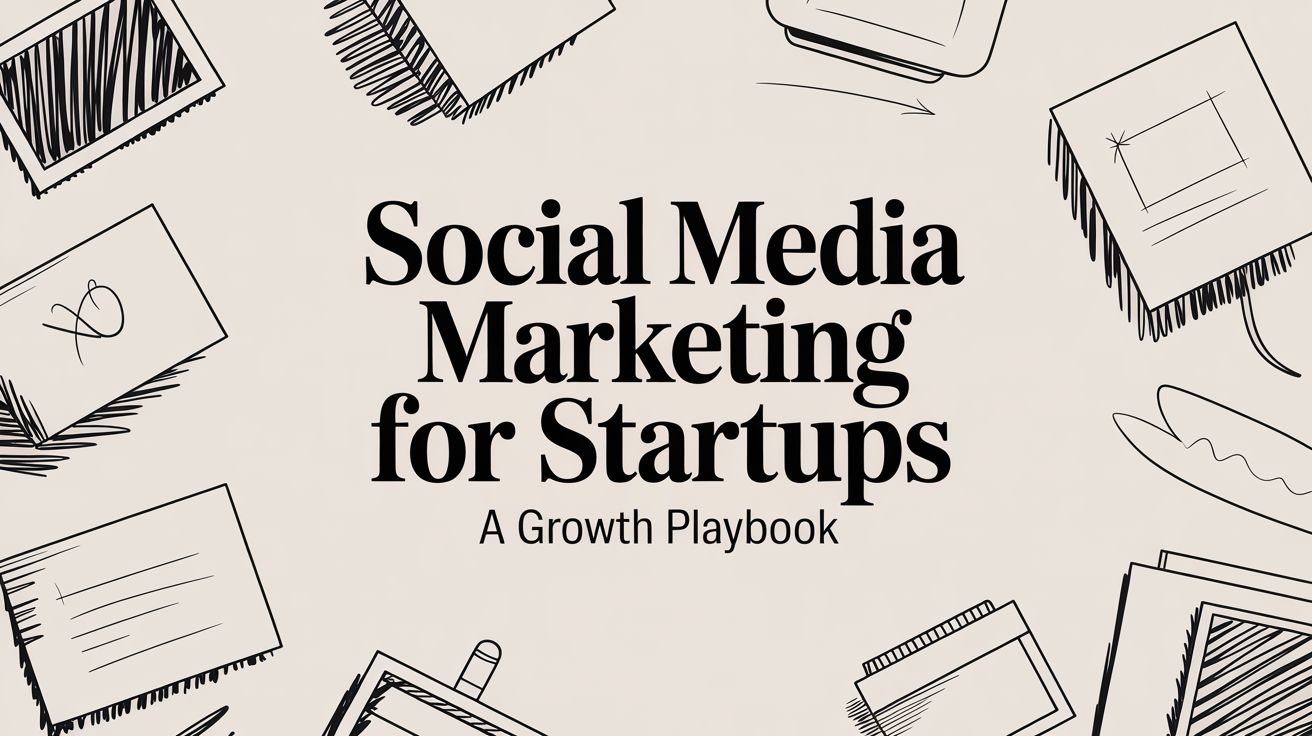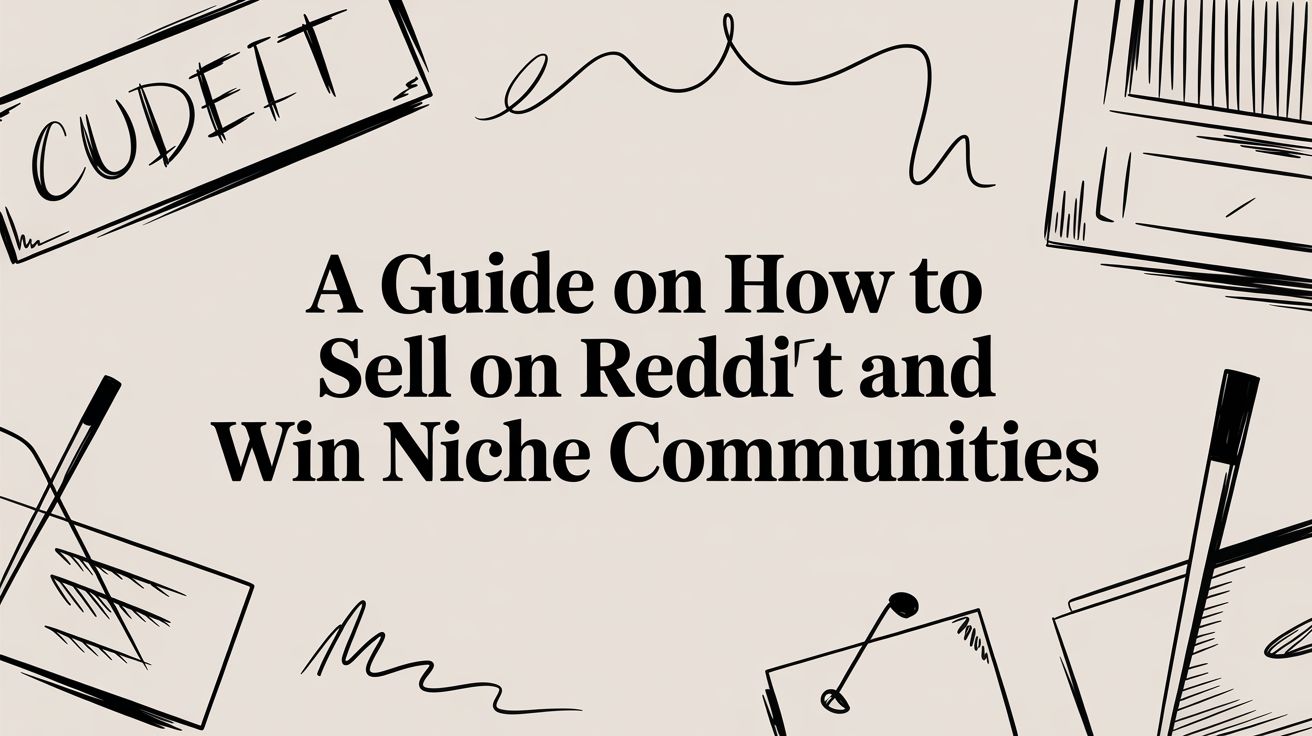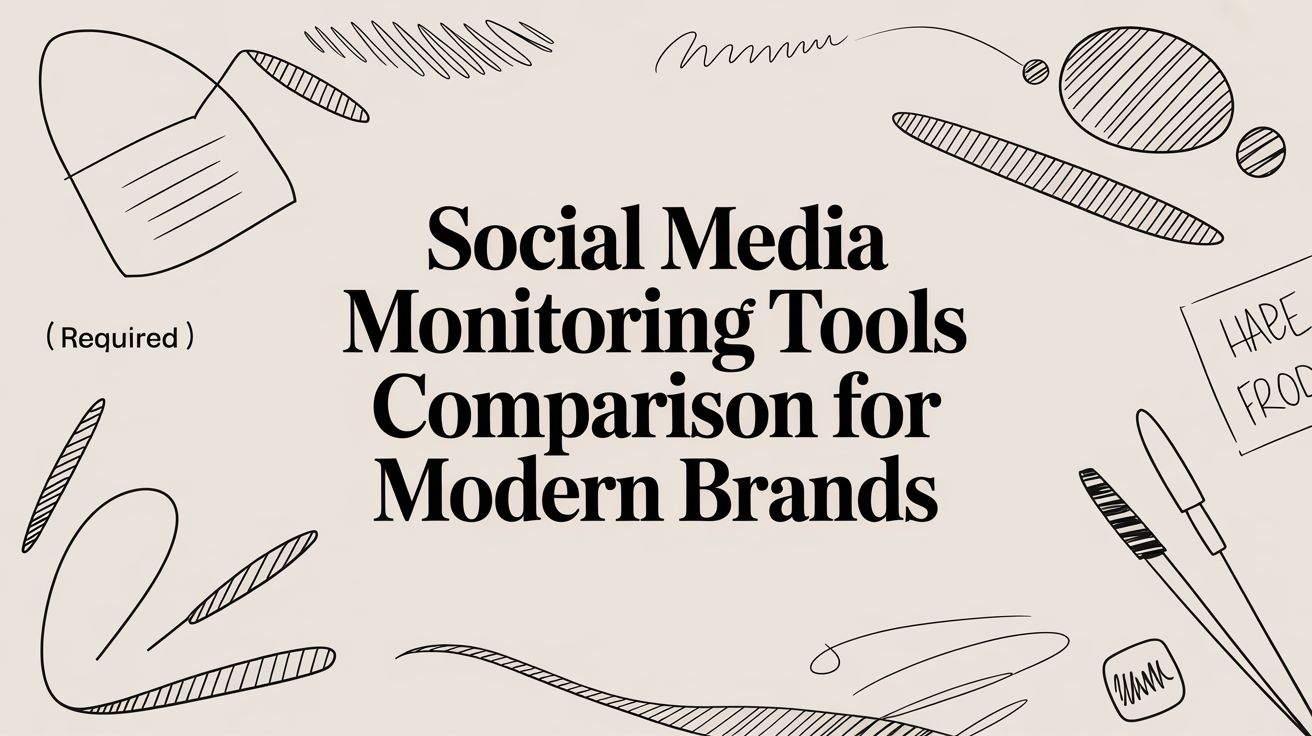Before you post a single thing, we need to talk about the foundation. Getting your startup's social media right from the start is all about laying the proper groundwork. It means setting real business goals, getting laser-focused on who you're talking to, and then—and only then—picking the right platforms. This isn't the sexy part, but it's the work that ensures your efforts actually move the needle.
Building Your Startup's Social Media Foundation
The classic startup mistake? Spreading yourself too thin by trying to be on every single social media platform. This "spray and pray" approach is a recipe for burnout and generic content that connects with no one. Time and money are your most precious resources; you can't afford to waste them.
The goal isn't to be everywhere. It's to be incredibly effective where it truly matters.
This means you need a deliberate strategy before you even think about content. What does winning actually look like for your business? Who are you trying to reach? Where do those people already hang out online? Answering these questions first is the difference between shouting into an empty room and building a real community around your brand.
Define Your Business-Oriented Goals
Let's get one thing straight: likes and follower counts are vanity metrics. They feel good, but they don't pay the bills. Your social media goals have to be directly wired into real business outcomes. What do you actually need social media to accomplish for your startup?
Start by asking the right questions:
- Brand Awareness: Are you launching a new SaaS product and need to get it in front of a niche audience of, say, project managers?
- Lead Generation: Is the main objective to drive sign-ups for your freemium plan or to get people on your newsletter?
- Community Building: Is your focus on creating a home for your first 100 users to give feedback and champion your mission?
- Customer Support: Will social media be a front-line channel for answering user questions and solving problems?
When you tie your social activities to core business objectives, measuring ROI becomes straightforward. A vague goal like "increase brand awareness" turns into a concrete target: "achieve 100,000 impressions among B2B tech founders on LinkedIn this quarter."
This simple flow is critical. Your goals inform your audience, and your audience dictates your platform.
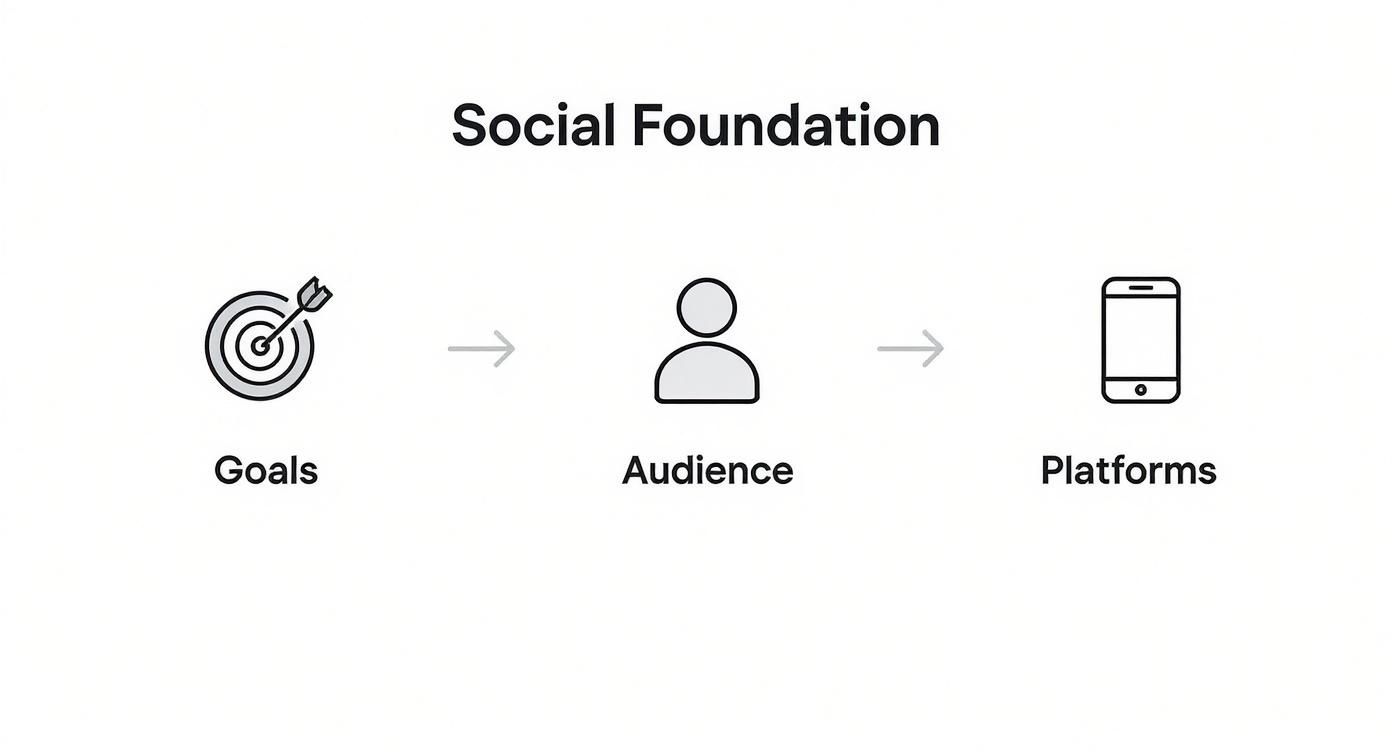
Each piece logically builds on the last. It’s a strategic choice, not a guess. To dig deeper into setting up your entire online presence, a solid small business social media strategy is a must-read.
Pinpoint Your Ideal Customer
You can't create content that hits home if you don’t know who you're talking to. Building a detailed ideal customer profile (ICP) is absolutely non-negotiable. Don’t just stop at demographics. You need to get into their heads and understand the psychographics—their attitudes, values, and habits.
Ask yourself things like:
- What are their biggest headaches at work?
- What blogs, newsletters, or podcasts are they obsessed with?
- Where do they spend their time online for work versus for fun?
- What kind of content do they actually find useful? (e.g., how-to guides, industry news, behind-the-scenes content, or even memes?)
A B2B fintech startup targeting CFOs will find its audience on LinkedIn, engaging in serious discussions about financial modeling. On the other hand, a D2C brand selling custom pet accessories will thrive with visual, personality-driven content on Instagram and TikTok.
Choose Your Platforms Wisely
With your goals and audience nailed down, now you can pick your channels. Instead of defaulting to the biggest names, choose platforms where your ideal customer is already active and looking for the kind of value you provide.
Here’s a simple framework to help you decide.
Platform Selection Framework for Startups
| Platform | Ideal for... | Primary Content Format | Startup Use Case |
|---|---|---|---|
| B2B networking, thought leadership, professional branding | Text posts, articles, carousels, video | A SaaS company sharing industry reports and case studies to attract enterprise clients. | |
| X (Twitter) | Real-time news, quick updates, engaging with industry trends | Short-form text (threads), images, video clips, polls | A Web3 startup joining live conversations and sharing project updates with developers. |
| Visual storytelling, brand building, influencer marketing | High-quality images, Reels (short video), Stories | A D2C fashion brand showcasing its products through user-generated content and lifestyle shoots. | |
| TikTok | Short-form video, creative trends, authentic brand personality | Vertical video (15-60 seconds) | A mobile app using funny, relatable skits to show how its product solves a common problem. |
| Building community, targeted advertising, local business | Images, video, events, text updates, Groups | A local subscription box service running targeted ads and managing a private group for subscribers. | |
| Niche communities, authentic engagement, gathering feedback | Text-based posts, AMAs, memes, discussions | A gaming startup engaging directly with players in subreddits like r/gaming to get early feedback. |
Don't feel pressured to master them all at once. Pick one or two platforms where you can genuinely build a presence. You can always expand later once you have a process that works. The key is to go deep, not wide.
Crafting a Lean Content Strategy That Connects
As a startup, your content strategy can't afford to be complicated. Forget the massive spreadsheets and Hollywood-level production schedules you see at big corporations. Your real superpower is agility, and that means building a lean content strategy—one that delivers maximum impact with minimal resources.
This is all about being consistently valuable, not just consistently busy. It’s the key to preventing the burnout that inevitably happens when a small team tries to do way too much. Instead of chasing every shiny new trend, you focus on creating a sustainable engine that builds trust and authority. The whole point is to make content a manageable, repeatable process that actually connects with people, turning passive scrollers into genuine fans.
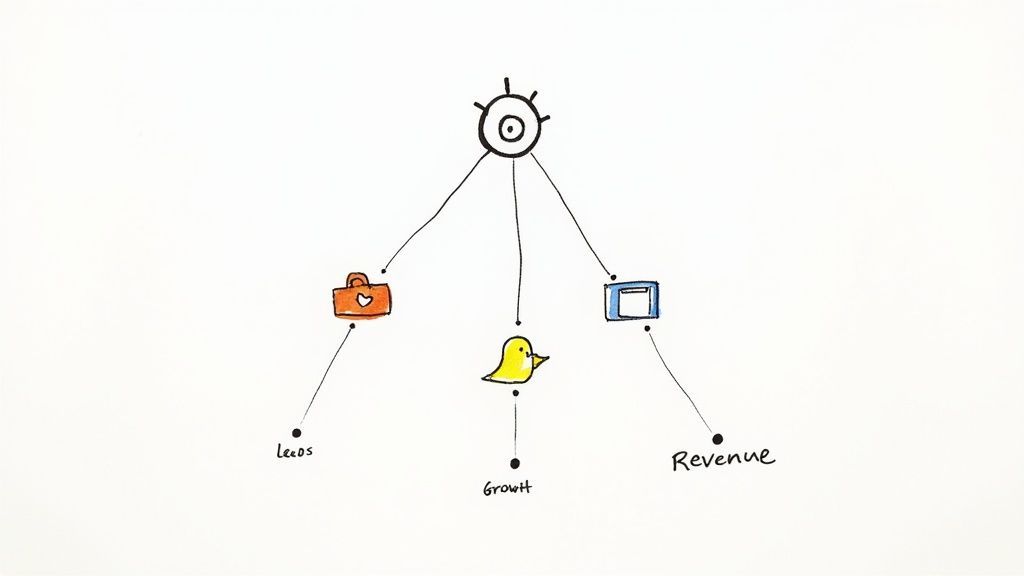
Build Your Content Around Core Pillars
Stop asking, "What should we post today?" every single morning. The first thing you need to do is define three to five core content pillars. Think of these as the big-picture themes your brand will own and talk about consistently. They should flow directly from your brand's mission, your audience's biggest pain points, and what makes your product genuinely useful.
Let's say you're a B2B SaaS startup with a project management tool. Your pillars might look something like this:
- Productivity Hacks: Actionable, quick tips for getting more done.
- Team Collaboration: Stories and frameworks for building a better team dynamic.
- Behind the Scenes: A look at your company culture and the real people building the product.
- Customer Wins: Highlighting how actual users are crushing their goals with your tool.
These pillars become the backbone of your content calendar. Every single piece of content you create should fit neatly into one of these buckets. This not only makes brainstorming a thousand times easier but also ensures your social feeds tell a clear, consistent story that reinforces what your brand is all about.
Focus on High-Impact, Low-Effort Formats
You don't need a professional video crew to make content that people actually care about. A lean strategy thrives on clever, resource-friendly formats that pack a ton of value. It's all about creating engaging content that truly connects without breaking the bank or your spirit.
Some of the most effective formats for startups I've seen are:
- Educational Carousels: Break down a complex topic into simple, swipeable slides. These are gold for shares and instantly position you as an expert.
- User-Generated Content (UGC): Nothing beats showing your actual customers using and loving your product. It’s the most authentic social proof there is, and it costs you nothing but the time to ask for it.
- Behind-the-Scenes Stories: Use Instagram or LinkedIn Stories to show the unpolished, human side of your startup. People connect with people, not logos.
- Text-Based Posts with a Strong Hook: A well-written thread on X (formerly Twitter) or a thoughtful LinkedIn post can easily outperform a slick video if the insight is sharp enough.
The secret weapon of a lean strategy is repurposing. A single customer success story can be a blog post, a series of quote graphics for Instagram, a LinkedIn carousel, and a short video testimonial for TikTok. Work smarter, not harder.
Create a Simple and Sustainable Content Calendar
Your content calendar doesn’t need to be some complex, color-coded beast. Seriously, a simple spreadsheet or a Trello board is all you need. The key is to plan just far enough ahead to be strategic but not so far that you lose the flexibility to jump on a trend or react to news. For most startups, a two-week rolling calendar is the sweet spot.
Your calendar just needs to track the basics:
- Publish Date/Time: When it's going live.
- Platform: Which channel it’s for.
- Content Pillar: Which of your core themes it supports.
- Format: Carousel, Reel, text-only, etc.
- Copy & Visuals: The actual content.
- Status: A simple tracker like Idea, In Progress, Ready for Review, Published.
This simple structure gives you clarity and accountability without drowning you in admin work. It also helps you see at a glance if you're hitting all your content pillars, keeping your feed fresh and interesting. Getting this framework right is what turns your social media from a chore into a powerful tool for growth and lead generation.
For a deeper dive, check out our guide on how to start https://replymer.com/blog/social-media-for-lead-generation.
Mastering Community-First Engagement
If you think of your social media feed as a megaphone, you're already on the fast track to being ignored. The real power isn't in shouting into the void; it's in treating your social presence like a living room—a place for real conversations. This is the heart of a community-first strategy, and it’s how you turn passive followers into your most vocal champions.
Forget the robotic "Great comment!" replies. It's time to dive into meaningful dialogue. Success isn't measured by how loud you are, but by how well you listen, participate, and add genuine value to the conversations already happening. This is how you build relationships that scale—by being consistently helpful, human, and present.
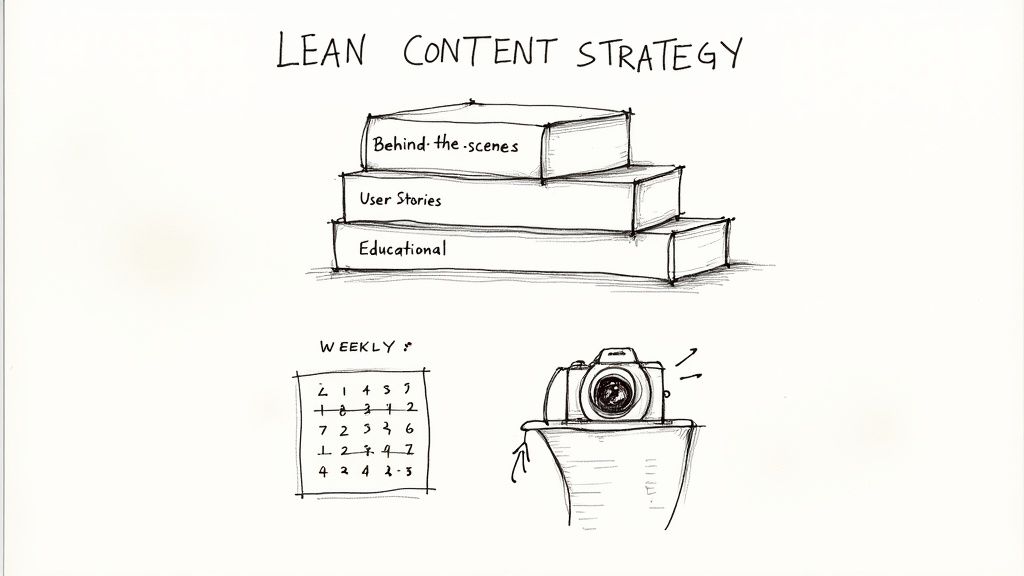
Go Beyond Generic Replies
Every single comment and mention is an opportunity, not a task to check off. Instead of just dropping a simple "thanks," you need to dig deeper. If someone compliments your product, ask them how they're using it or what specific feature is making a difference for them. This does more than just make them feel heard; it hands you invaluable user insights on a silver platter.
Let's say you run a project management tool and see a comment like, "Your new timeline feature is a game-changer!"
- The Generic Reply: "Thanks so much! Glad you like it." (This kills the conversation.)
- The Community-First Reply: "That's awesome to hear! Are you using it for sprint planning or long-term roadmaps? We'd love to know more about your workflow."
See the difference? That simple shift in framing opens the door for a real conversation. It shows you genuinely care about their experience, not just their praise.
Create a Simple Monitoring Workflow
You can't join conversations you don't even know are happening. As a startup, you need a lean but effective system for social listening. This doesn't mean you need to buy expensive software right away—a few simple tools and a bit of dedicated time are all it takes to get started.
Set up alerts for a few key things:
- Your brand name: Don't forget to include common misspellings!
- Key industry terms: Keep an eye on conversations around the problems your product actually solves. A startup like Replymer, for example, would be watching for terms like "social selling" or "Reddit marketing."
- Competitor mentions: Find out what people are saying about others in your space. What are their biggest frustrations or most requested features? This is free market research.
A simple workflow can be incredibly effective. Just dedicate 15 minutes twice a day—once in the morning and once in the afternoon—to scan these keywords. The goal is consistency, not being plugged in 24/7. This small time commitment keeps you from missing key opportunities to connect.
Activate Micro-Influencers and User-Generated Content
Your community is your most powerful marketing engine, period. Two of the best ways to fire it up are by working with micro-influencers and encouraging user-generated content (UGC). Micro-influencers, with their smaller but highly engaged audiences, often deliver endorsements that feel far more authentic and trustworthy than a big-name celebrity.
The influencer marketing industry is projected to hit an estimated $32.55 billion globally, a clear signal of its importance. For startups, the sweet spot is with micro-influencers—those with 10,000 to 100,000 followers. They deliver an average engagement rate of 3.86%, blowing away the 1.21% seen with macro-influencers. With 61% of consumers trusting influencer recommendations over brand ads, these partnerships are a shortcut to building credibility. The financial return is there, too, averaging $5.78 for every $1 spent. You can dig deeper into the numbers with these startup marketing statistics and their implications.
At the same time, you should be actively celebrating your users. Create a unique hashtag and encourage customers to share their wins. When someone posts about your product, don't just "like" it. Share it to your Stories, feature it on your main feed (with their permission, of course), and give them a public shout-out. This gives you a steady stream of authentic content and strengthens the bond with your most passionate users, making others want to join in.
Measuring Social Media Success Beyond Likes
It's easy to get caught up in the day-to-day of posting great content and chatting with your community. But how do you actually know if any of it is working? Chasing likes and piling up followers feels productive, but honestly, those are mostly vanity metrics. They look nice on a report, but they don't tell you if you're actually moving the needle for the business.
To prove the value of your social media efforts, you have to connect your activity to real, tangible outcomes. Are people actually clicking through to your site? Are they signing up for your newsletter or, better yet, becoming paying customers? It's all about shifting your focus from "look at us" metrics to the numbers that truly matter for a growing startup.
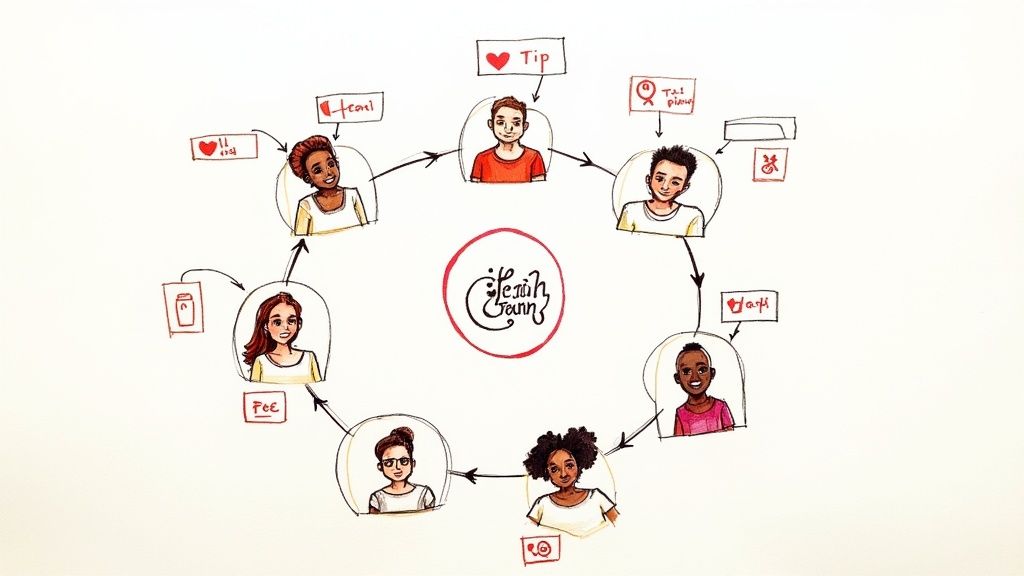
Distinguishing Vanity From Actionable Metrics
The first, most critical step is learning to spot the difference between metrics that make you feel good and metrics that make your business grow.
- Vanity Metrics: These are the numbers that are easy to track but often have zero correlation with business success. Think follower count, raw likes, and even impressions. A huge follower count means nothing if none of those people ever engage, visit your site, or buy from you.
- Actionable Metrics: These are the data points that tie directly back to your business goals. They show you exactly how your social media work is influencing user behavior and driving results. We're talking about things like website clicks, conversion rate, leads generated, and cost per acquisition (CPA).
Focusing on actionable metrics forces you to ask the right question with every post: "How is this helping us hit our main goal?"
Setting Up Your Measurement Foundation
You don't need a complicated, expensive analytics suite to get started. The tools you need are probably already available to you, and most are free. Your goal is to create a simple, clean system that connects the dots between a social media post and a real business outcome.
Your foundation only needs two key components to start:
- Platform Analytics: Every social platform has its own built-in dashboard (like LinkedIn Page Analytics or Instagram Insights). Use these to track what's happening on the platform—engagement, reach, and click-throughs. This is your first layer of data.
- Website Analytics: Tools like Google Analytics 4 are non-negotiable. By adding UTM parameters—which are just special tags you add to your URLs—you can see exactly how many people came to your site from a specific LinkedIn post versus an Instagram Story. This is how you trace social activity directly to website traffic and conversions.
For a startup, the most powerful insight is seeing which social channels drive the most qualified traffic to your site. If you see that 80% of your demo sign-ups from social media come from LinkedIn, you know exactly where to double down on your efforts.
Creating a Simple KPI Framework
Once your tracking is in place, you can build a Key Performance Indicator (KPI) framework. This is just a simple way of mapping your social media metrics directly back to the business goals you defined earlier. It ensures every action you take is deliberate and measured.
This framework should clearly align your goals with specific, measurable KPIs. This kind of targeted approach is fundamental to success and is a cornerstone of strategies on how to generate B2B leads through digital channels.
Here’s a look at what a basic but effective KPI dashboard could look like for a startup.
Startup Social Media KPI Dashboard
| Business Goal | Primary KPI | Secondary Metrics | Tools for Tracking |
|---|---|---|---|
| Increase Brand Awareness | Reach & Impressions | Follower Growth, Shares, Brand Mentions | Platform Analytics (LinkedIn, X, etc.) |
| Drive Website Traffic | Click-Through Rate (CTR) | Clicks to Website, Bounce Rate, Time on Page | Platform Analytics, Google Analytics |
| Generate Leads | Conversion Rate | Form Submissions, Demo Requests, Newsletter Sign-ups | Google Analytics, CRM Software |
| Build Community | Engagement Rate | Comments, Replies, User-Generated Content (UGC) mentions | Platform Analytics, Community Tools |
This simple table transforms your measurement process from a guessing game into a clear, data-informed strategy. By checking in on these KPIs weekly or bi-weekly, you can quickly spot what’s working, what’s a waste of time, and where to invest your limited startup resources for the biggest impact.
Essential Tools and Workflows to Stay Lean
As a startup, your biggest edge isn't a massive budget; it's efficiency. You don't have a huge team, so you have to make every minute and every dollar count. This is where a smart tech stack and a smooth workflow become non-negotiable.
The whole point is to automate the repetitive tasks so you can pour your energy into what actually matters—genuine conversations and community building. Forget the enterprise software that costs a fortune. Your goal is to find free or low-cost tools that pack a serious punch.
Assembling Your Lean Social Media Toolkit
A great toolkit isn't about collecting the most apps; it's about finding the right apps that work together seamlessly. Your stack should cover the three pillars of social media management: scheduling, creation, and listening.
Here are a few of my go-to recommendations for getting started on a budget:
- Content Scheduling: You can't go wrong with Buffer or Later. Their free plans are incredibly generous and let you schedule posts across your key channels. This alone will save you from the daily panic of having to post manually. Later's visual planner, in particular, is a lifesaver for Instagram.
- Simple Graphic Design: Canva is the undisputed king here. Even on the free plan, you get access to thousands of templates and design elements. It empowers anyone, designer or not, to create professional-looking graphics that stay on brand.
- Social Listening: You don't need to spend big to keep an ear to the ground. Start with the basics. Set up Google Alerts for your brand name and key industry terms. On platforms like X (formerly Twitter), you can create private lists of competitors and thought leaders—a completely free way to monitor important conversations.
This is what I mean by a visual planner. Seeing your grid laid out like this in Later helps you curate a cohesive aesthetic without the daily guesswork. It’s all about planning ahead to maintain quality and consistency.
Building a Workflow That Scales
Tools are just one part of the equation. A well-designed workflow is what will keep your small team agile and prevent things from falling through the cracks. You can make a massive difference with a simple, three-part system.
The Content Approval Bottleneck Buster
For a small team, a complicated, multi-layered approval process is just a time-waster. It kills momentum.
Instead, create a shared content calendar—a simple Trello board or Google Sheet is perfect for this. Use simple status tags like "Draft," "Ready for Review," and "Approved." The rule is simple: if a post is in the "Approved" column by Friday afternoon, it gets scheduled. No need for a dozen follow-up emails.
Your workflow is the operating system for your social media strategy. A lean workflow is designed for speed and consistency, allowing a one-person team to operate with the output of three. It’s about creating systems that do the heavy lifting for you.
The Engagement Management System
Don't let engagement run your day. If you're constantly checking for notifications, you'll never get any deep work done.
Try blocking out specific, dedicated time for it. I recommend 15 minutes in the morning and 15 minutes in the afternoon. Use these blocks only for responding to comments, checking DMs, and looking at your listening feeds. This batching approach is way more efficient than being reactive 24/7 and ensures you're consistently showing up for your community.
Answering the Tough Questions About Social Media for Startups
Getting started with social media always brings up the same handful of questions. Every founder I've worked with has wrestled with these, so let's cut through the noise and get you some straight answers based on what actually works in the trenches.
How Much Should We Really Be Spending on Social Media?
Early on, your biggest investment isn't cash—it's your own time. Forget about a big budget. Your first goal is to build an organic foundation by creating content that genuinely helps people and personally engaging with your first one hundred users. You're building a community here, and that's something money just can't buy.
When you're ready to dip your toes into paid ads, a good rule of thumb is to allocate about 5-10% of your total marketing budget. But don't just throw it at the wall. Start small. I'm talking $10 to $20 a day on a few experimental ads. Test your audiences, play with your messaging, and see what creative hits home. The whole point is to prove you can get a positive return on investment (ROI) before you even think about scaling up.
The mantra should be: prove it, then scale it. Lean on the incredible number of free tools out there for scheduling, design, and analytics. Keep your costs rock bottom while you figure out what truly resonates.
This way, you’re not guessing; every dollar you eventually spend will be backed by real data.
What's the Best Platform for a B2B Startup?
For B2B, LinkedIn is your home base. No contest. It’s where business happens—the go-to for professional networking, sharing deep industry knowledge, and getting in front of the exact decision-makers you need to reach. The playbook here is to build up the personal brands of your founders, share insightful articles or carousels, and become an active voice in relevant groups.
But don’t put all your eggs in one basket. Other platforms are fantastic supporting players.
- X (formerly Twitter): Nothing beats it for real-time conversation. It’s the perfect spot to connect with journalists, chat with industry leaders, and jump into trending discussions.
- Instagram: You might not think of it as a B2B channel, but if you have a visual product, you can find a solid niche. Use it for sharp data visualizations, a peek behind the curtain at your team culture, or quick video tutorials.
Think of it as a hub-and-spoke model, with LinkedIn as the solid anchor for your B2B strategy.
Seriously, How Long Until We See Any Results?
Let's be real: organic social media is a long game. It's a marathon, not a sprint. Sure, a post could go viral overnight, but that's like winning the lottery—it's not a business strategy. Building a real community that actually trusts you takes time and unwavering consistency.
You should start seeing some encouraging signs—a steady climb in followers and engagement—within 3-6 months of consistent, daily effort. The kind of results that actually impact the bottom line, like reliable website traffic and qualified leads, typically start showing up in the 6-12 month range.
The secret ingredient is just not giving up. The initial growth will feel slow. Don't let it get you down. Keep your eyes on the long-term prize: building genuine relationships.
Ready to turn social conversations into customers without the grind? Replymer uses real people to find high-intent discussions about your industry on Reddit, X, and LinkedIn, then crafts authentic replies that recommend your product. See how it works.
